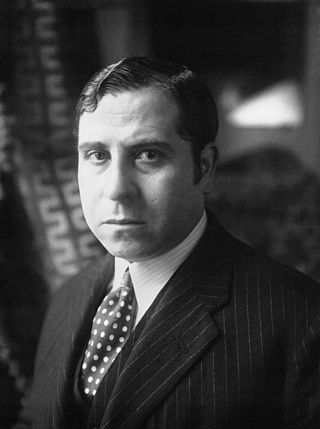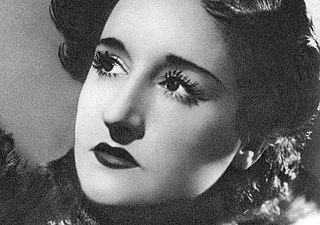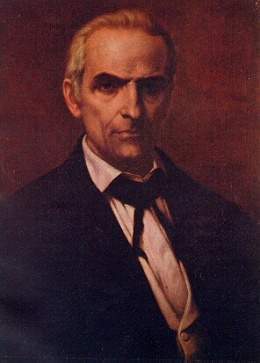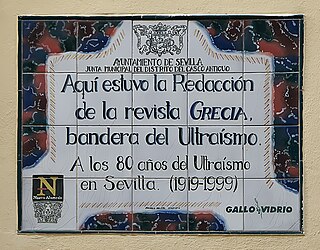
Ramón Gómez de la Serna y Puig, born in Madrid, was a Spanish writer, dramatist and avant-garde agitator. He strongly influenced surrealist film maker Luis Buñuel.

The Manifesto of Futurism is a manifesto written by the Italian poet Filippo Tommaso Marinetti, published in 1909. In it, Marinetti expresses an artistic philosophy called Futurism, which rejected the past and celebrated speed, machinery, violence, youth, and industry. The manifesto also advocated for the modernization and cultural rejuvenation of Italy.
The Generation of '27 was an influential group of poets that arose in Spanish literary circles between 1923 and 1927, essentially out of a shared desire to experience and work with avant-garde forms of art and poetry. Their first formal meeting took place in Seville in 1927 to mark the 300th anniversary of the death of the baroque poet Luis de Góngora. Writers and intellectuals paid homage at the Ateneo de Sevilla, which retrospectively became the foundational act of the movement.

Maruja Mallo was a Spanish surrealist painter. She is considered an artist of the Generation of 1927 within the Spanish avant-garde movement.
Martín Fierro was an Argentine literary magazine which appeared from February 1924 to 1927. It was one of the leading avant-garde magazines in the country.
La Conquista del Estado was a magazine based in Madrid, Spain.

Jorge Mañach y Robato was a Cuban writer and attorney, considered among the most distinguished of his time.

Guillermo de Torre Ballesteros was a Spanish essayist, poet and literary critic, a Dadaist and member of the Generation of '27. He is also notable as the brother-in-law of the Argentine writer Jorge Luis Borges.

José Cipriano de la Luz y Caballero was a Cuban scholar, acclaimed by José Martí as "the father ... the silent founder" of Cuban intellectual life of the 19th century. Interest in Luz's work was revived around the time of the Cuban Revolution, and new editions of his work published, as he was regarded as a wellspring of intellectual autonomy for the country.
Ernesto Giménez Caballero, also known as Gecé, was a Spanish writer, diplomat, and pioneer of Fascism in Spain. Director and founder of the avant-garde magazine La Gaceta Literaria (1927–1932), his work has been categorized as being part of the Futurist and Surrealist movement, while Stanley G. Payne has described him as the Spanish Gabriele d'Annunzio.
Luis Rosales Camacho was a Spanish poet and essay writer member of the Generation of '36.
Amalia Galárraga Azcarrunz was a Spanish feminist. She was one of the founders of the Lyceum Club of Madrid, and treasurer of its executive committee.
Octubre was a Communist literary magazine which was published in Madrid between 1933 and 1934. The subtitle of the magazine was Escritores y artistas revolutionarios.
Vértice was a monthly Falangist magazine published in Spain, between 1937 and 1946. Its subtitle was Revista nacional de la Falange. From late 1937 its subtitle was redesigned as Revista nacional de Falange Española Tradicionalista y de las J.O.N.S. The magazine was one of the early propaganda publications which supported the rule of Francisco Franco.
Prometeo was a monthly avant-garde magazine which existed between 1908 and 1912 in Madrid, Spain. The magazine was established by the avant-garde writer Javier Gómez de la Serna. Its subtitle was revista social y literaria.
Revista de Avance was a Cuban avant-garde magazine which existed between 1927 and 1930 in Havana. It was the media outlet of a group, minorism, which had been established in 1923 to support social and political change in Cuba. The magazine was described by Francine Masiello as "the most handsome product of avant-garde creative activity in Cuba and perhaps in Spanish." It functioned as a platform to gather the leading Cuban artists of the period.
Noi: Rivista d’arte futurista was an avant-garde magazine which adopted a futurist stance. It was published in Rome between 1917 and 1925. Its subtitle was Raccolta internazionale d’arte d’avanguardia.
Zwrotnica was an avant-garde magazine which was one of the significant publications in Poland. It appeared in Kraków in two periods: first between 1922 and 1923, and then between 1926 and 1927. Despite its short run, it is the first Polish avant-garde magazine that had an international audience.

Grecia was a literary magazine which was published from 1918 to 1920 in Spain. Its subtitle was Revista Decenal de Literatura. Later it was redesigned as Revista de literatura. It was a traditionalist as reflected in its title and modernist publication in the early years, but later adopted an avant-garde approach and became the flagship of the ultraísmo.







